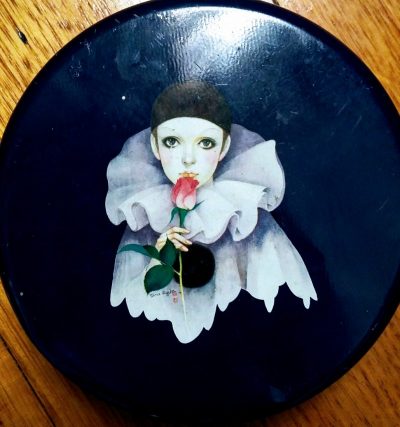Pierrot in Popular Culture
People often give me blank looks if I say my books are about the Commedia dell’Arte. Italian Renaissance improvised theatre is not well known today. Those who have done theatre studies or drama are likely to know about it, but most don’t. Audiences might remember seeing Commedia-style plays like A Servant of Two Masters and the hilarious musical The Venetian Twins, by Australian playwright Nick Enright.
However, if I mention my books are about Pierrot, Harlequin and Columbine, sometimes people’s eyes light up. Pierrot, more than any other character, still has name recognition. This is ironic, because the character was originally very minor. But there is something about his pathos and romantic adoration of Columbine that touches people. Not only that, but the image of Pierrot is iconic.
Mirano Fujita and the Sad Clown
 For anyone of my era, feminised versions of Pierrot are very familiar. During the 1980s these images were everywhere. In my early teens I received a birthday gift of a tin with two soaps and a facewasher inside. All had one of Mira Fujita’s sad clowns on them. The soaps are long gone, but I still treasure the tin.
For anyone of my era, feminised versions of Pierrot are very familiar. During the 1980s these images were everywhere. In my early teens I received a birthday gift of a tin with two soaps and a facewasher inside. All had one of Mira Fujita’s sad clowns on them. The soaps are long gone, but I still treasure the tin.
Fujita was the daughter of a calligrapher. After studying at art school in Japan, she began doing illustrations for a girl’s magazine. Her work stood out because the characters seemed willful rather than meek. With the growth of manga over traditional storytelling in Japan, Fujita moved to Europe. There her style was considered novel and mysterious.
A Parisian poster company commissioned Fujita to do a series of images of clowns and Harlequins. These were extraordinarily popular and soon sold as prints and on various household goods. A large number of teenage girls in the 1980s had a Pierrot poster on their wall as a result!
Who was Pierrot?
There is an early (1547) reference to a Piero in Commedia history but the character seemed to disappear for decades. In the 1570s it reappeared as Pagliaccio, then Pedrolino. Pedrolino was very low-status, usually played by the youngest son in family player troupes. His early name derived from pagliaio, meaning a pile of straw, since the youngest often slept in the barn with the animals. Around 1665, as the Commedia grew in popularity in France, Pedrolino took on a French name: Pierrotto. This was ultimately shortened to Pierrot.
Pierrot wears baggy clothes because he is the youngest, and only receives hand-me-downs. Unlike other Commedia characters, he doesn’t wear a mask. Instead, he paints his face with white flour. This means the actor can be far more expressive. Perhaps this is why people remember Pierrot, more than other Commedia characters, for his big heart and sad expressions. He is highly sensitive, conscientious and totally honest. In writing the Tales of Tarya these seemed to me to be the perfect characteristics of a hero. In my fantasy series Luka not only plays Pierrot, he bears many of the characteristics of this iconic character.
Other Pop-Culture References
 Pierrot has inspired many artists. One of the most obvious is David Bowie. For the video of ‘Ashes to Ashes’ he wore a Pierrot costume. He also wore one on the sleeve of the album Scary Monsters. The Seekers’ song ‘The carnival is over’, features the line: ‘but the joys of love are fleeting/for Pierrot and Columbine’. Musicians from Brazil to Italy to Japan have written songs or albums featuring the sad clown. There was even a Japanese rock band named Pierrot.
Pierrot has inspired many artists. One of the most obvious is David Bowie. For the video of ‘Ashes to Ashes’ he wore a Pierrot costume. He also wore one on the sleeve of the album Scary Monsters. The Seekers’ song ‘The carnival is over’, features the line: ‘but the joys of love are fleeting/for Pierrot and Columbine’. Musicians from Brazil to Italy to Japan have written songs or albums featuring the sad clown. There was even a Japanese rock band named Pierrot.
It’s still possible to find Pierrot (and Harlequin) themed decorative items. Generally the best place to look is in op shops. The Commedia dell’Arte may be mostly forgotten. But the sad clown lives on and can still evoke a sense of romance, pathos and gentleness.



 were core characters, including the old men, Pantalone and Il Dottore, the lovers, the servants (known as zanni), Il Capitano (the Captain) and Columbina. Then there were secondary characters such as Pulcinella (later Pierrot), Scaramuccia and others. Harlequin, or Arlecchino as he was originally known, was one of the servants.
were core characters, including the old men, Pantalone and Il Dottore, the lovers, the servants (known as zanni), Il Capitano (the Captain) and Columbina. Then there were secondary characters such as Pulcinella (later Pierrot), Scaramuccia and others. Harlequin, or Arlecchino as he was originally known, was one of the servants.